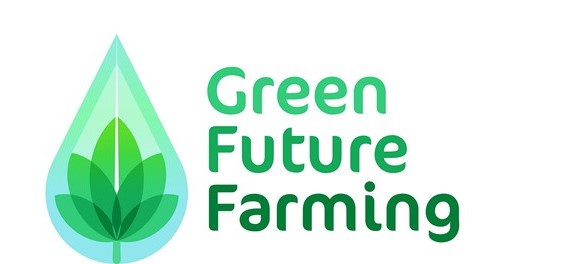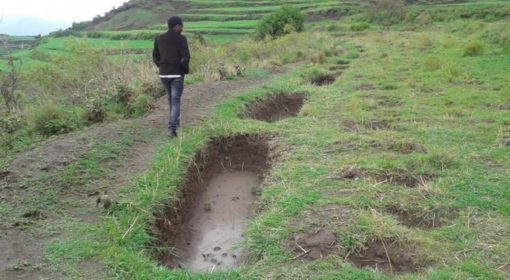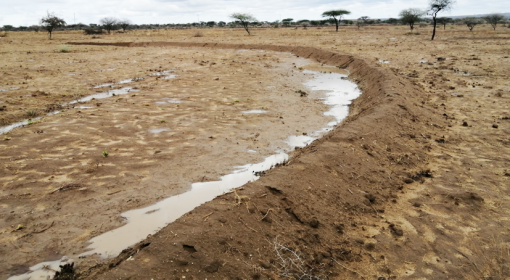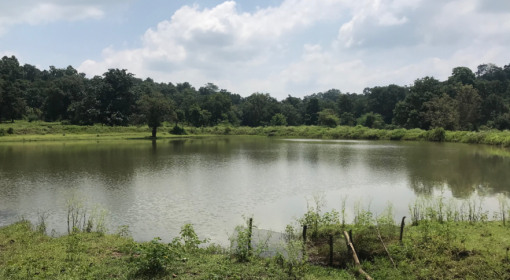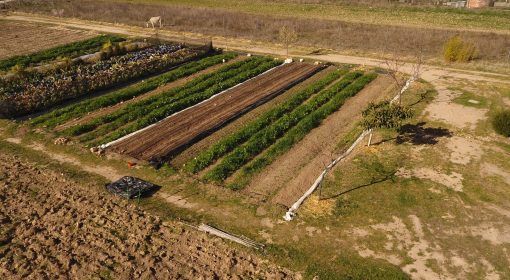By Francesco Sambalino
October 18, 2021
A lot is said about climate change. It is too hot. It will become too hot. Higher rainfall intensity will make flooding more likely. Sad enough, the practical know-how on how small farmers can navigate these situations is not center stage. We think it should be. What tools do we have to adapt to soaring temperatures? In this blog, we explain a couple of strategies we are experimenting with on our vegetable farm.
Producing vegetables in the Spanish Meseta central can be difficult. High temperatures are averaging about 33 degrees Celsius, with peaks touching and surpassing 40 degrees being more and more frequent. Lettuce is a good example: with excessive heat, its natural response is to switch from vegetative to flowering too early. From crunchy sweet leaves to bitter and unsellable greens. Yet we are stubborn, and we wanted to make our customers happy with some crispy head lettuces.
There are several strategies when trying to reduce plant heat stress:
- Variety and phenological stage
- Apply sunscreen
- Increase shade
- Transform sensible heat in latent heat
- Mulching
Varieties and phenological stage
Our lettuce drill in a nutshell: We start seedlings in the nursery with the ½ inches soil blockers. After 30-40 days, the seedlings are ready for transplanting in the open field. Another 30-40 days and head lettuce can be harvested.
Lettuce is typically a spring/autumn crop. However, some varieties resist the heat better than others. This summer, we tried four of them.
Soon each variety told us what they wanted to be in the hot summer months. Three strains stopped producing as soon as they spent two weeks in the bed: they wanted to be flowers and pursued their aspiration with fierce determination. The only loyal lettuce that decided to stick to its leafy form was the Maravilla de Verano. However, between July and August also this variety gave up. It was only around mid-august that we could plant once again.
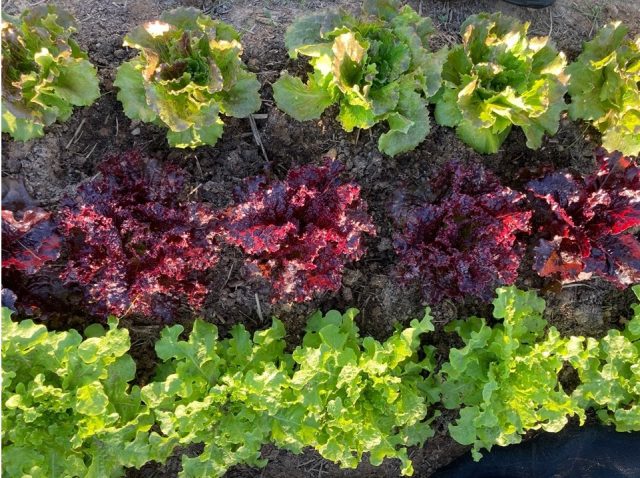
We always try new varieties to pair our climate with the most suitable strains. This research is not over, and we are confident that we’ll perfect our lettuce assortment to be more resilient year by year.
When producing full lettuce heads is difficult, we may also take a different approach by harvesting it young and selling it as baby salad. There are some varieties on the market that are particularly good for this.
Apply sunscreen
During a summer day, the sun can easily be too intense for most of our crops. Too much for the tender lettuce? That is quite obvious, but who would have expected it to be too much also for the tomato? We are experimenting with coating leaves with natural substances that have the effect of sunscreen.
We are dusting pole beans with diatomaceous earth with a double function. The tiny crystals pierce through the skin of soft-bodied aphids and cause their dehydration. Our beans aphids – and the ants shepherding them – will hopefully be under control. As a side-effect, the dusting also acts as a sunscreen on the plant, reflecting part of the solar radiation back into the atmosphere.
We didn’t try it yet, but another opportunity is wetting leaves with a solution of water and kaolinite clay (Abou-Khaled et al. 1970, Cantore et al. 2009). The lighter colour of the clay increases the albedo rate of the leave. As a result, more energy is reflected instead of being absorbed. It is sometimes used to protect seedlings from heat shock when transplanting in the heat of the summer.
Increase Shade
Is it too hot? You find shelter in the shade. Plants can’t move yet, but in the vegetable garden we can help them by providing some shade (Júnior et Al. 2019, Cometti et Al., 2020). At least during the hottest hours of the afternoon.
At the moment, we are working with two types of shade nets.
The first type of net is a row cover that screens 40% of the incident light and helps to lower down the temperature of what’s beneath it. We installed the net on rebar hoops set across each growing bed every 3-4 meters. The net is then held in place with metal clamps.
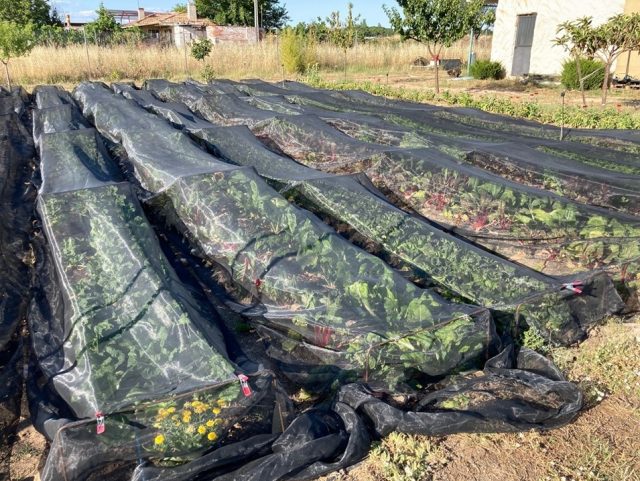
We placed a thermometer under the shade net and one in the full sun to see the temperature difference. We used simple household devices that were designed to measure air temperature. By placing them directly on top of the dark soil, we are probably recording higher temperatures. However, the difference between the two recordings remains stark and shows the effect of reduced solar radiation on the plant microclimate. The average maximum temperature is 7,5 °C lower under the shade nets.
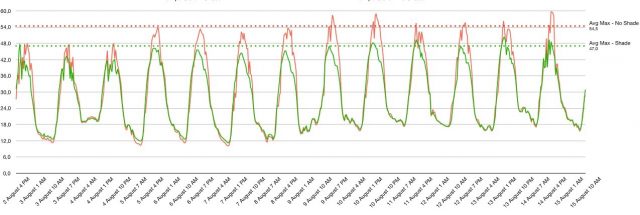
The net has some other benefits. It keeps rabbits away, and it creates a barrier against leaves munching insects. However, if they make it inside, they will be very happily stuck with a never-ending supply of food. True, the net will also be a barrier for pollinators, but it is not a problem because we only use the net on leaves crops.
The second type of shade net is a meter wide, and we hang it on top of every other tomato row. It screens 50% of the light and is very porous to air movement. That is a big plus in a place where wind can be pretty intense and can easily rip away more impermeable materials.
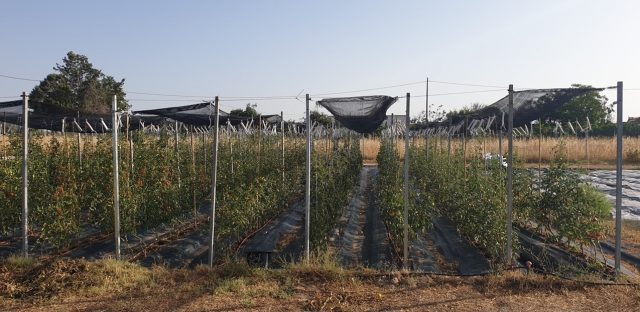
Transform heat in latent heat
When the sun heats the ground, two things happen. First, the energy from the sun heats up the soil and ultimately the air above it (sensible heat flux). Second, the energy from the sun is consumed in evaporation processes (latent heat flux). Both processes compete for the same solar energy: the more energy is used in evaporation processes; the less energy is available to heat up the soil and air. This means that when the soil is moist and evaporation is possible, soil temperatures won’t become scorching hot because the sun’s energy is used to evaporate water in a process. However, when soil moisture levels become limited, this also limits the evaporation process and thus the latent heat flux. When this happens, more energy will become available for the sensible heat flux and the soil will heat up more quickly. This can be trouble for the tender plants.
Our market garden is set up with drip lines that allocate water right at the plants’ roots. It is far more efficient than aspersion and flooding methods. However, its temperature buffering effect is also much lower. That is why in the heat of the summer months, it may be an idea to provide some short burst of water with overhead sprinklers or spray tubes. This won’t only cool down the soil, but also the leaves. Scared of burning your plants? In our experience, that’s a myth.
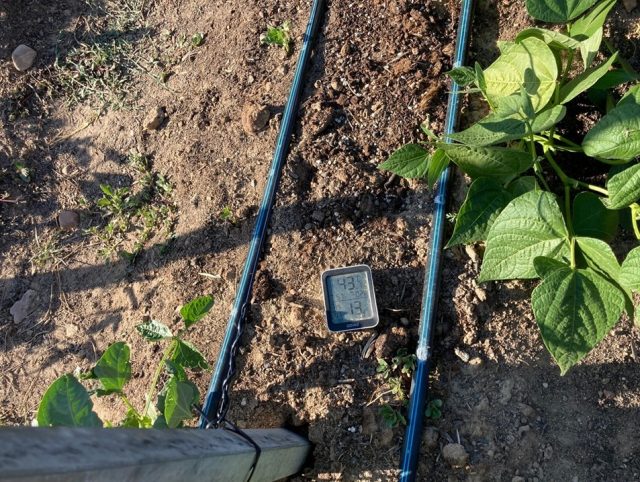
Mulching
Plastic mulches were introduced to influence the soil energy balance and permit earlier sowing in cold soils (Emmert, 1957). Soon, it became clear that plastic mulches effectively control other factors such as Water Use Efficiency and weeds emergence (Waggoner et Al. 1960). Besides the negative environmental impact, plastic mulches are also likely to overheat the soil in a hot and arid environment like ours. That is why we are more likely to benefit from the use of straw mulch, which on the opposite, is known to lower soil temperatures and create a better microclimate for the plants (Jabran, 2019).
When this growing season is over, we will plant our vegetable beds with winter cover crops. In spring, we will terminate the crop but leave all the residues on the ground to form a thick mulch layer in which we will transplant all our vegetables directly.
References
Abou-Khaled, A., Hagan, R.M., & Davenport, D.C., 1970, Effects of kaolinite as a reflective antitranspirant on leaf temperature, transpiration, photosynthesis, and water‐use efficiency. Water Resources Research, 6, 280-289.
Cantore, Vito et al., 2009, Kaolin-based particle film technology affects tomato physiology, yield and quality, Environmental and Experimental Botany 66: 279-288.
Cometti, N.N., Silva, J.N., Zonta, E., & Cessa, R.M., 2020, A little shade helps lettuce grow better in a tropical environment, but too much shade causes the farmer to lose money. Horticultura Brasileira, 38.
Emmert, E.M., 1957, Black Polyethylene for mulching vegetables, Proceedings American Society of Horticulture,
Jabran Khawar, 2019, Role of Mulching in Pest Management and Agricultural Sustainability, Springer International Publishing, https://doi.org/10.1007/978-3-030-22301-4
Júnior, C.D., Queiroga, R., Sousa, C.D., Figueiredo, C.C., Mesquita, E.F., Pereira, F., Júnior, S.O., Alves, J.M., Lima, A.S., & Santos, A.P, 2019, Shading on Yield and Quality of Lettuce Cultivars in Semiarid Conditions. The Journal of Agricultural Science, 11, 162.
Waggoner, P., 1960, Plastic mulching: principles and benefits, New Haven: Connecticut Agricultural Experiment Station.
